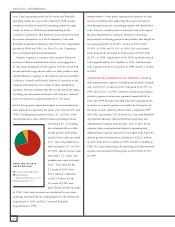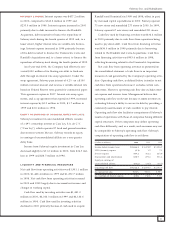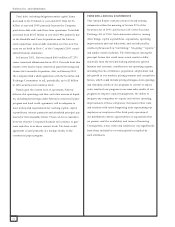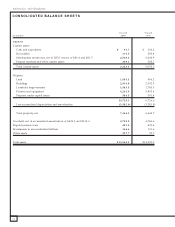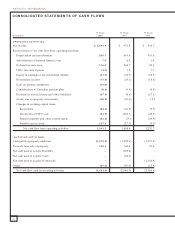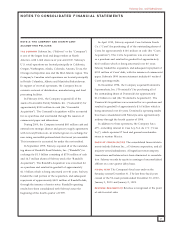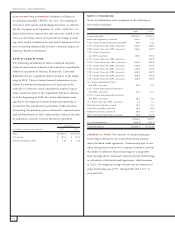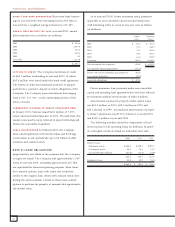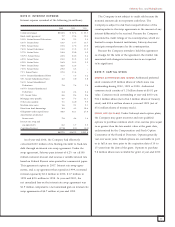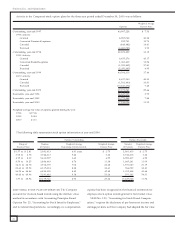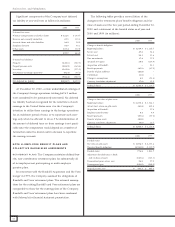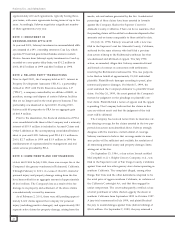Safeway 2000 Annual Report Download - page 32
Download and view the complete annual report
Please find page 32 of the 2000 Safeway annual report below. You can navigate through the pages in the report by either clicking on the pages listed below, or by using the keyword search tool below to find specific information within the annual report.
Safeway Inc. and Subsidiaries
30
USE OF ESTIMATES The preparation of financial statements
in conformity with accounting principles generally accepted in
the United States of America requires management to make
estimates and assumptions that affect the reported amounts
of assets and liabilities and disclosure of contingent assets
and liabilities at the date of the financial statements, and the
reported amounts of revenues and expenses during the report-
ing period. Actual results could differ from those estimates.
TRANSLATION OF FOREIGN CURRENCIES Assets and liabili-
ties of the Company’s Canadian subsidiaries and Casa Ley are
translated into U.S. dollars at year-end rates of exchange, and
income and expenses are translated at average rates during the
year. Adjustments resulting from translating financial statements
into U.S. dollars are reported, net of applicable income taxes,
as a separate component of comprehensive income in the
consolidated statements of stockholders’ equity.
CASH AND CASH EQUIVALENTS Short-term investments
with original maturities of less than three months are
considered to be cash equivalents.
MERCHANDISE INVENTORIES Merchandise inventory of
$1,846 million at year-end 2000 and $1,823 million at year-
end 1999 is valued at the lower of cost on a last-in, first-out
(“LIFO”) basis or market value. Such LIFO inventory had a
replacement or current cost of $1,926 million at year-end
2000 and $1,905 million at year-end 1999. Liquidations of
LIFO layers did not have a significant effect on the results of
operations. All remaining inventory is valued at the lower of
cost on a first-in, first-out (“FIFO”) basis or market value.
The FIFO cost of inventory approximates replacement or
current cost.
Vendor allowances and credits that relate to the Company’s
buying and merchandising activities are recognized as a
reduction of costs of goods sold as earned.
PROPERTY AND DEPRECIATION Property is stated at cost.
Depreciation expense on buildings and equipment is com-
puted on the straight-line method using the following lives:
Stores and other buildings 7 to 40 years
Fixtures and equipment 3 to 15 years
Property under capital leases and leasehold improvements
are amortized on a straight-line basis over the shorter of the
remaining terms of the lease or the estimated useful lives of
the assets.
SELF-INSURANCE The Company is primarily self-insured
for workers’ compensation, automobile and general liability
costs. The self-insurance liability is determined actuarially,
based on claims filed and an estimate of claims incurred
but not yet reported. The present value of such claims was
calculated using a discount rate of 6.0% in 2000 and 1999.
The current portion of the self-insurance liability of
$103.4 million at year-end 2000 and $103.2 million at
year-end 1999 is included in Other Accrued Liabilities in
the consolidated balance sheets. The long-term portion of
$195.7 million at year-end 2000 and $243.2 million at
year-end 1999 is included in Accrued Claims and Other
Liabilities. Claims payments were $132.0 million in 2000,
$123.6 million in 1999 and $98.2 million in 1998. The
total undiscounted liability was $352.2 million at year-end
2000 and $391.9 million at year-end 1999.
INCOME TAXES The Company provides a deferred tax
expense or benefit equal to the change in the deferred tax
liability during the year in accordance with Statement of
Financial Accounting Standards (“SFAS”) No. 109,
“Accounting for Income Taxes.” Deferred income taxes rep-
resent tax credit carryforwards and future net tax effects
resulting from temporary differences between the financial
statement and tax basis of assets and liabilities using enacted
tax rates in effect for the year in which the differences are
expected to reverse.
OFF-BALANCE SHEET FINANCIAL INSTRUMENTS As dis-
cussed in Note E, the Company has entered into interest
rate swap agreements to limit the exposure of certain of its
floating-rate debt to changes in market interest rates. Interest
rate swap agreements involve the exchange with a counter-
party of fixed and floating-rate interest payments periodically
over the life of the agreements without exchange of the
underlying notional principal amounts. The differential to be
paid or received is recognized over the life of the agreements
as an adjustment to interest expense. The Company’s coun-
terparties are major financial institutions.


